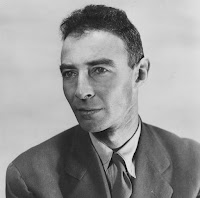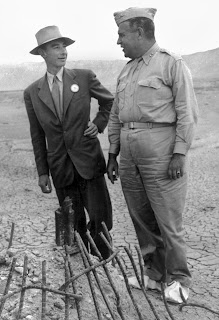J. Robert Oppenheimer, Biological Physicist
 |
| J. Robert Oppenheimer. |
Did you watch Oppenheimer in the theater this summer? I did. The movie told how J. Robert Oppenheimer led the Manhattan Project that built the first atomic bomb during World War II. But the movie skipped Oppenheimer’s research in biological physics related to photosynthesis.
Russ Hobbie and I only make a passing mention of photosynthesis in Chapter 3 of Intermediate Physics for Medicine and Biology.
The creation of glucose or other sugars is the reverse of the respiration process and is called photosynthesis. The free energy required to run the reaction the other direction is supplied by light energy.
 |
| From Photon to Neuron, by Philip Nelson. |
To learn more about Oppie and photosynthesis, I turn to Philip Nelson’s wonderful textbook From Photon to Neuron: Light, Imaging, Vision. His discussion of photosynthesis begins
Photosynthetic organisms convert around 1014 kg of carbon from carbon dioxide into biomass each year. In addition to generating the food that we enjoy eating, photosynthetic organisms emit a waste product, free oxygen, that we enjoy breathing. They also stabilize Earth’s climate by removing atmospheric CO2.
Nelson begins the story by introducing William Arnold, Oppenheimer’s future collaborator.
W. Arnold was an undergraduate student interested in a career in astronomy. In 1930, he was finding it difficult to schedule all the required courses he needed for graduation. His advisor proposed that, in place of Elementary Biology, he could substitute a course on Plant Physiology organized by [Robert] Emerson. Arnold enjoyed the class, though he still preferred astronomy. But unable to find a place to continue his studies in that field after graduation, he accepted an offer from Emerson to stay on as his assistant.
Emerson and Arnold went on to perform critical experiments on photosynthesis. Then Emerson performed another experiment with [Charlton] Lewis, in which they found that chlorophyll does not absorb light with a wavelength of 480 nm (blue), but an accessory pigment called phycocyanin does. Emerson and Lewis concluded that “the energy absorbed by phycocyanin must be available for photosynthesis.”
Here is where Oppenheimer comes into the story. I will let Nelson tell it.
Could phycocyanin absorb light energy and somehow transfer it to the chlorophyll system?…Arnold eventually left Emerson’s lab to study elsewhere, but they stayed in contact. Emerson told him about the results with Lewis, and suggested that he think about the energy-transfer problem. Arnold had once audited a course on quantum physics, so he visited the professor for that course to pose the puzzle. The professor was J. R. Oppenheimer, and he did have an idea. Oppenheimer realized that a similar energy transfer process was known in nuclear physics; from this he created a complete theory of fluorescence resonance energy transfer. Oppenheimer and Arnold also made quantitative estimates indicating that phycocyanin and chlorophyll could play the roles of donor and acceptor, and that this mechanism could give the high transfer efficiency needed to explain the data.
So, what nuclear energy transfer process was Oppenheimer talking about? In Arnold and Oppenheimer’s paper, they wrote
It is the purpose of the present paper to point out a mechanism of energy transfer from phycocyanin to chlorophyll, the efficiency of which seems to be high enough to account for the results of Emerson and Lewis. This new process is, except for the scale, identical with the process of internal conversion that we have in the study of radioactivity.
Internal conversion is a topic Russ and I address in IPMB. We said
Whenever a nucleus loses energy by γ decay, there is a competing process called internal conversion. The energy to be lost in the transition, Eγ, is transferred directly to a bound electron, which is then ejected.
 |
| Introductory Nuclear Physics, by Kenneth Krane. |
More detail can be found in Introductory Nuclear Physics by Kenneth Krane.
Internal conversion is an electromagnetic process that competes with γ emission. In this case the electromagnetic multipole fields of the nucleus do not result in the emission of a photon; instead, the fields interact with the atomic electrons and cause one of the electrons to be emitted from the atom. In contrast to β decay, the electron is not created in the decay process but rather is a previously existing electron in an atomic orbit. For this reason internal conversion decay rates can be altered slightly by changing the chemical environment of the atom, thus changing somewhat the atomic orbits. Keep in mind, however, that this is not a two-step process in which a photon is first emitted by the nucleus and then knocks loose an orbiting electron by a process analogous to the photoelectric effect; such a process would have a negligibly small probability to occur.
Nelson compares the photosynthesis process to another process widely used in biological imaging: Fluorescence resonance energy transfer (FRET). He describes FRET this way.
We can find pairs of molecular species, called donor/acceptor pairs, with the property that physical proximity abolishes fluorescence from the donor. When such a pair are close, the acceptor nearly always pulls the excitation energy off the donor, before the donor has a chance to fluoresce. The acceptor may either emit a photon, or lose its excitation without fluorescence (“nonradiative” energy loss).
Let’s put this all together. The donor in FRET is like the phycocyanin molecule in photosynthesis is like the nucleus in internal conversion. The acceptor in FRET is like the chlorophyll molecule in photosynthesis is like the electron cloud in internal conversion. The fluorescence of the donor/phycocyanin/nucleus is suppressed (in the nuclear case, fluorescence would be gamma decay). Instead, the electromagnetic field of the donor/phycocyanin/nucleus interacts with, and transfers energy to, the acceptor/chlorophyll/electron cloud. In the case of FRET, the acceptor then fluoresces (which is what is detected when doing FRET imaging). The chlorophyll/electron cloud does not fluoresce, but instead ejects an electron in the case of internal conversion, or energizes an electron that can ultimately perform chemical reactions in the case of photosynthesis. All three processes are exquisitely sensitive to physical proximity. For FRET imaging, this sensitivity allows one to say if two molecules are close to each other. In photosynthesis, it means the chlorophyll and phycocyanin must be near one another. In internal conversion, it means the electrode cloud must overlap the nucleus, which implies that the process usually results in emission of a K-shell electron since those innermost electrons have the highest probability of being near the nucleus.
There’s lots of interesting stuff here: How working at the border between disciplines can result in breakthroughs; how physics concepts can contribute to biology; how addressing oddball questions arising from data can lead to new breakthroughs; how quantum mechanics can influence biological processes (Newton rules biology, except when he doesn’t); how seemingly different phenomena—such as FRET imaging, photosynthesis, and nuclear internal conversion—can have underlying similarities. I wish my command of quantum mechanics was strong enough that I could explain all these resonance effects to you in more detail, but alas it is not.
 |
| Oppenheimer and General Groves at the Trinity test site. I love Oppie’s pork pie hat. |
If you haven’t seen Oppenheimer yet, I recommend you do. Go see Barbie too. Make it a full Barbenheimer. But if you want to learn about the father of the atomic bomb’s contributions to biology, you’d better stick with From Photon to Neuron or this blog.
The official trailer to Oppenheimer.
https://www.youtube.com/watch?v=bK6ldnjE3Y0
Photosynthesis.
https://www.youtube.com/watch?v=jlO8NiPbgrk&t=14s
Source: http://hobbieroth.blogspot.com/2023/10/j-robert-oppenheimer-biological.html
Anyone can join.
Anyone can contribute.
Anyone can become informed about their world.
"United We Stand" Click Here To Create Your Personal Citizen Journalist Account Today, Be Sure To Invite Your Friends.
Please Help Support BeforeitsNews by trying our Natural Health Products below!
Order by Phone at 888-809-8385 or online at https://mitocopper.com M - F 9am to 5pm EST
Order by Phone at 866-388-7003 or online at https://www.herbanomic.com M - F 9am to 5pm EST
Order by Phone at 866-388-7003 or online at https://www.herbanomics.com M - F 9am to 5pm EST
Humic & Fulvic Trace Minerals Complex - Nature's most important supplement! Vivid Dreams again!
HNEX HydroNano EXtracellular Water - Improve immune system health and reduce inflammation.
Ultimate Clinical Potency Curcumin - Natural pain relief, reduce inflammation and so much more.
MitoCopper - Bioavailable Copper destroys pathogens and gives you more energy. (See Blood Video)
Oxy Powder - Natural Colon Cleanser! Cleans out toxic buildup with oxygen!
Nascent Iodine - Promotes detoxification, mental focus and thyroid health.
Smart Meter Cover - Reduces Smart Meter radiation by 96%! (See Video).





